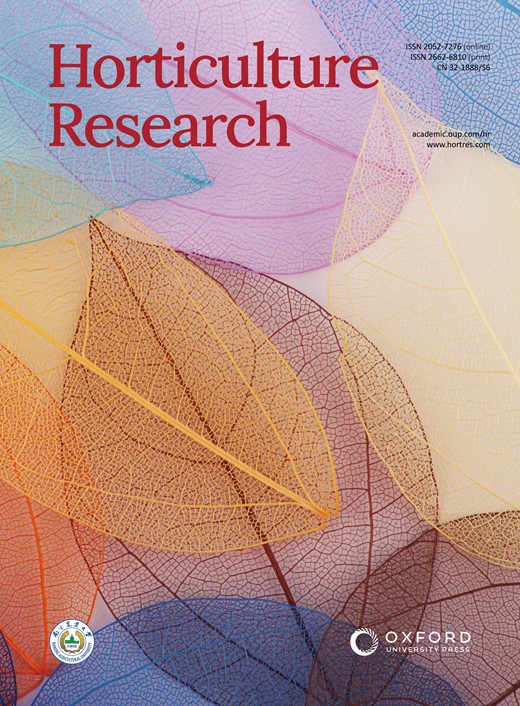SEP同源基因TEMARY调节大叶女贞的花序表型
IF 8.7
1区 农林科学
Q1 Agricultural and Biological Sciences
引用次数: 0
摘要
大多数绣球花品种的花序由两种花组成:萼片艳丽的装饰花和普通的非装饰花。在大绣球花(H. macrophylla)的野生植物中,装饰花位于伞房花序的外围,形成花冠表型。然而,在发现了装饰花不仅开在伞房花序外围,而且开在整个花序上的拖把头表型后,它作为园林植物得到了显著发展。在这项研究中,我们旨在确定控制花序类型的基因以及导致拖头表型的突变。连锁分析确定了一个 SEPALLATA(SEP)同源基因为候选基因,命名为 TEMARY。我们利用几个栽培品种分析了 TEMARY 的基因组序列。结果显示,H. macrophylla 栽培品种有三种功能缺失等位基因,而 mophead 栽培品种的基因座仅由功能缺失等位基因组成。27个大头栽培品种的表型可由三种功能缺失的TEMARY等位基因解释。利用与花序型相关的两个芽运动突变株进行的 RNA-seq 分析和 qRT-PCR 分析表明,拖把头突变株不能正常表达 TEMARY。这些结果表明,TEMARY 控制着花序类型,该基因突变会导致 mophead 表型。本文章由计算机程序翻译,如有差异,请以英文原文为准。
The SEP homologous gene TEMARY regulates inflorescence phenotypes in H. macrophylla
Most Hydrangea species have inflorescences composed of two types of flowers: decorative flowers with showy sepals, and plain non-decorative flowers. In wild plants of H. macrophylla, the decorative flowers are located at the periphery of the corymb, resulting in the lacecap phenotype. However, after the discovery of the mophead phenotype, in which decorative flowers are borne not only at the periphery but also on the entire inflorescence, it developed remarkably as a garden plant. In this study, we aimed to identify the gene controlling the inflorescence type and the mutations causing the mophead phenotype. Linkage analyses identified a SEPALLATA (SEP) homologous gene as a candidate gene, named TEMARY. We analyzed the genome sequences of TEMARY using several cultivars. The results revealed that the H. macrophylla cultivars had three types of loss-of-function alleles, and that the locus of the mophead cultivars consisted of only loss-of-function alleles. The phenotypes of 27 mophead cultivars could be explained by three types of loss-of-function TEMARY alleles. RNA-seq analysis and qRT-PCR analysis using two bud sport mutant lines related to the inflorescence type revealed that mophead mutants did not express TEMARY normally. These results suggest that TEMARY controls the inflorescence type and that mutations in this gene cause the mophead phenotype.
求助全文
通过发布文献求助,成功后即可免费获取论文全文。
去求助
来源期刊

Horticulture Research
Biochemistry, Genetics and Molecular Biology-Biochemistry
CiteScore
11.20
自引率
6.90%
发文量
367
审稿时长
20 weeks
期刊介绍:
Horticulture Research, an open access journal affiliated with Nanjing Agricultural University, has achieved the prestigious ranking of number one in the Horticulture category of the Journal Citation Reports ™ from Clarivate, 2022. As a leading publication in the field, the journal is dedicated to disseminating original research articles, comprehensive reviews, insightful perspectives, thought-provoking comments, and valuable correspondence articles and letters to the editor. Its scope encompasses all vital aspects of horticultural plants and disciplines, such as biotechnology, breeding, cellular and molecular biology, evolution, genetics, inter-species interactions, physiology, and the origination and domestication of crops.
 求助内容:
求助内容: 应助结果提醒方式:
应助结果提醒方式:


